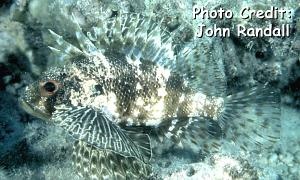
By Bob Goemans

Likely Reef Tank Suitable
Likely Fish-Only Tank Suitable
Range: Eastern Central Pacific Ocean: Hawaiian and Johnston Islands.
Size: 6 inches (16 cm)
Natural Environment: Inhabits areas under ledges in turbid lagoons and clear seaward reefs and often found at depths between 3 - 150 feet (1 - 45 m) where it feeds on small fishes and crustaceans.
General Husbandry: Occasionally seen in the trade, having a motttled brown and white body and fins, with its pectoral fins quite large.
Best maintained in aquariums with minimum water currents, as this is a slow moving species, and with tankmates large enough not to be eaten, nor would nip its large fins. Caves and ledges should also be provided as those in this genus like to hide during daylight hours, and hunt prey during evening hours.
As to diet, these fish are carnivores and require a diet high in protein and amino acids (lipids/fats). Products such as marine fish and crustacean flesh, clams, and other marine meaty foods should make up the majority of their diet.
As to live foods, occasional small live mollies and/or guppies can provide for that natural feeding excitement found in the wild should live marine fish not be available. Nevertheless, feeding small freshwater live fish should be considered a special treat and not become a steady diet since they lack the fatty acids that marine fish need to stay healthy.
Also, keep in mind that feeder goldfish, which cannot survive but a few minutes in seawater, also carry many different bacteria, fungi, and protozoa that can cause parasitic and infectious diseases. Furthermore, feeder goldfish can also cause blockage in the digestive track and/or kidney along with liver damage due to fatty degeneration in the consuming fish. And this will ultimately lead to the consumer’s death. In fact, fatty liver degeneration is a common cause of death in cases where marine fish are fed a diet that primarily consists of goldfish (as with Lionfish for example). Also, its possible the large air bladder in the goldfish can upset the internal balance in this fish, sometimes causing it to float at the surface, possibly killing it.
Non-living foodstuffs can be suspended/impaled on a long thin stick and dangled within range to entice feeding.
May be difficult to feed in the early days in the aquarium and if so, (if live marine fish are not available) live glass/grass shrimp and/or small crabs, e.g., fiddler crabs may be needed to sustain the fish.
Because these are not overly active fish, their metabolism is somewhat low and two to three feedings per week should suffice nicely.
Taxonomy:
Order: Scorpaeniformes
Suborder: Scorpaenoidei
Family: Scorpaenidae
Subfamily: Pteroinae
Genus: Dendrochirus
FYI: Has venomous dorsal fin spines - take special care when your hand is near this species!
Mainly a live food consumer.
More easily maintained in small aquariums.
Can be maintained in reef aquariums if there are no small fishes or ornamental shrimps.
Experience Level: Intermediate
Temperament: Semi-aggressive
Diet: Carnivore
Coral Safe: Yes
Fish Safe: With caution
Invertebrate Safe: With caution
Acclimation Time: 30 minutes+
Aquarium Environment: Reef or fish-only aquarium
Tankmates: Peaceful
Minimum Tank Size: 30 gallons
Temperature Range: 70 - 80°F (21 – 27°C)
Specific Gravity: 1.020 - 1.026
pH: 8.0 - 8.5
